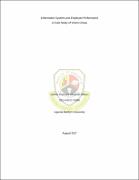| dc.description.abstract | The title of this study is Information System and Employee Performance. The general objective of this study was to investigate the effect of Information Systems on the performance of the employees at Vision Group Uganda. Specifically, the study was out to establish the effect of hardware and software on performance of employees of Vision Group; find out whether networks have a role to play with respect to the performance of employees Vision group and; to assess the effects of Information Systems processes on employee performance at Vision group.
A descriptive research design and specifically, the study was a case study. The study used a case study of Vision Group hence the study area was in the Central Division of Kampala. The study population was the employees of the organization irrespective of the level, tenure and the designation at the organization. The study sample used a probability proportional to size sampling to state the number of respondents per department and simple random sampling to select the sampling unit from the total number in the department. Thus, the study sample was 169. The researcher used questionnaire as the main instrument of data collection. Data was gathered by use of questionnaire, processed by editing, and computing. It was also analyzed by use of descriptive statistics (frequency tables, pie charts and bar graphs). The researcher used Pearson’s correlation coefficient to determine the relationship between the two variables which were Information System and employee performance. In order for the study to investigate the effect of IS on employee performance, the study used multiple regression analysis at a 5% significance level.
The findings indicated that there is a 79.0% relationship between the independent variables and employee performance at Vision Group. At a 5% significance level, relationship between IS and performance of the employees at Vision Group. The findings indicated that for every unit increase (perceived improvement by employees) in Hardware & Software, Networks, End users and IS processes, perceived employee performance improved by 70.9%, 53.6%, -16.7% and 0.4% respectively. This literally means that there a significant positive perceptions of the employees towards the relevance of hardware and software as well as networks on their perceived performance.
The study recommends that in a bid to improve perceptions about the impact, the company should always make sure that functional hardware is availed to the employees and the software needs to be upgraded so that it is scalable and user friendly. The study advises Vision Group to make more investments towards improving the reliability of the networks available. The study recommends that the group streamline the Information System processes for improved performance. | en_US |


